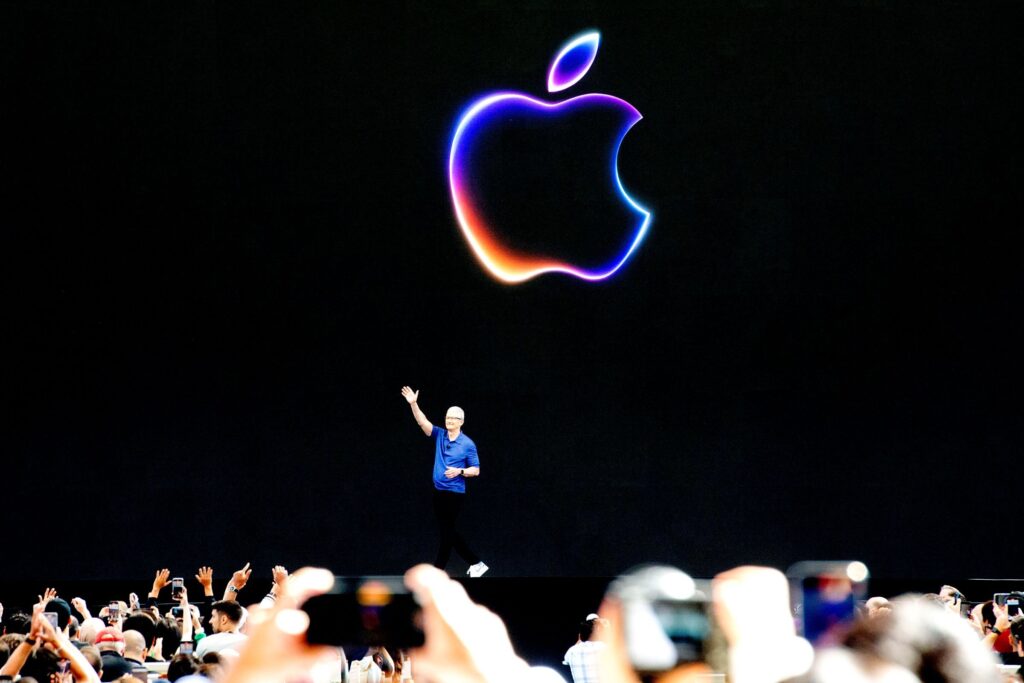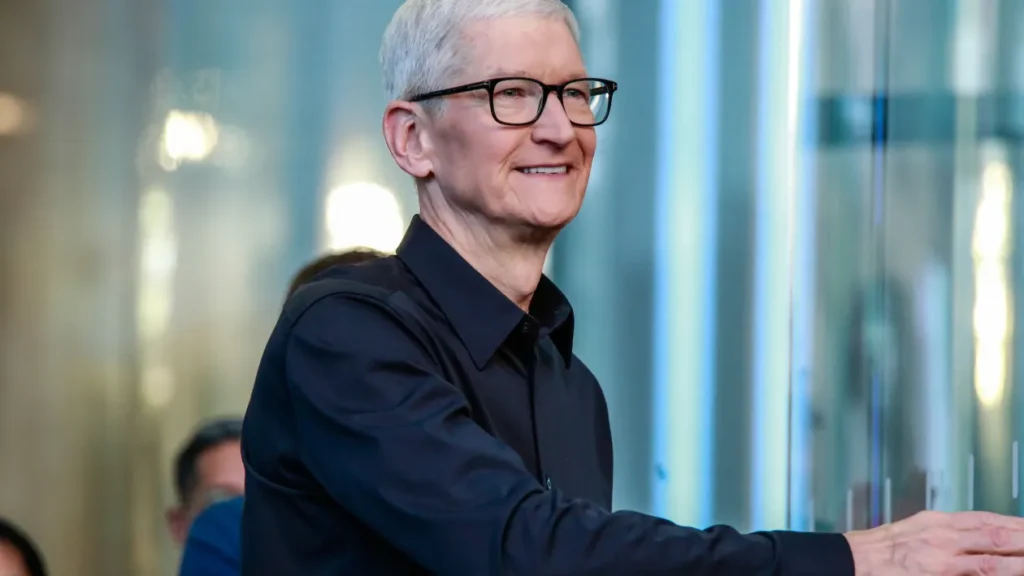Apple Q4 2025 Earnings: Apple has once again reminded the world why it’s the most valuable company on Earth. In the final quarter of fiscal year 2025, the tech giant delivered a performance that outshined every expectation. Apple reported $102.5 billion in revenue and earnings per share (EPS) of $1.85, beating Wall Street estimates.
This is a strong rebound after a few uncertain quarters earlier in the year. The driving force behind this success? The iPhone 17 series, a booming services business, and early signs of renewed consumer confidence as 2025 ends. Investors cheered, analysts nodded, and Apple’s stock ticked up — again.

A Closer Look at Q4 2025 Numbers (Apple Q4 2025 Earnings)
Let’s break it down clearly.
| Key Metric | Result | YoY Change | Highlights |
|---|---|---|---|
| Total Revenue | $102.5 billion | +9% | Beat forecasts |
| Net Income | $27.5 billion | +6% | Solid growth |
| EPS | $1.85 | Up from $1.70 | Above expectations |
| iPhone Revenue | $46.2 billion | +11% | iPhone 17 sales surge |
| Services Revenue | $24.1 billion | +14% | Record high |
| Mac Revenue | $11.3 billion | +4% | Stable demand |
| Wearables & Home | $10.6 billion | flat | Slight slowdown |
| Greater China Revenue | $13.1 billion | -2% | Competitive pressure |
These numbers show a company that has found its rhythm again. Apple isn’t just surviving — it’s thriving in a tough market.
The iPhone 17 Effect: The Comeback Phone
The iPhone 17 lineup is proving to be one of Apple’s smartest moves in years. After a slower iPhone 16 cycle, many users were waiting for something exciting — and Apple delivered. The iPhone 17 Pro Max brought a titanium frame, next-gen A19 Bionic chip, and deep AI-driven photo features that wowed consumers. Even the base model saw strong demand, especially in Europe and the U.S., where carrier upgrade deals made it easier for older iPhone users to switch. Tim Cook called it “our strongest iPhone launch since the 12 series,” highlighting how the product line reignited upgrade momentum. Social media buzz around its AI camera and battery performance only fueled more sales.

Why Services Are the Real Star
While iPhones keep headlines busy, the real hero behind Apple’s steady growth is the Services division. Apple’s services — including the App Store, Apple Music, iCloud, Apple TV+, Apple Pay, and AppleCare — generated $24.1 billion this quarter alone.
That’s not just big — it’s historic. Services now make up over 23% of total revenue, up from 18% three years ago. This shift shows how Apple’s ecosystem strategy is paying off. Once a customer buys an iPhone, they’re pulled into a loop of recurring services: streaming, storage, and subscriptions. It’s sticky, profitable, and future-proof. Analysts estimate the services profit margin at around 70%, nearly double the iPhone margin. Simply put — iPhones bring people in, but services keep them spending.
Mac, iPad, and Wearables: The Support Crew
Apple’s other product lines may not have stolen the spotlight, but they held their ground. The Mac saw a small uptick thanks to strong demand for the M4-powered MacBook Pro. Creative professionals and developers praised its speed and battery efficiency. The iPad business also recovered slightly with new educational bundles and enterprise deals. As for Wearables, Home, and Accessories, Apple Watch sales remained steady, though not explosive. The new Apple Watch Ultra 3 drew loyal fans but faced stiff competition from cheaper fitness brands. The takeaway — Apple’s core ecosystem remains balanced, with each category contributing to overall stability.

Samsung Galaxy Watch Ultra (2025)
Take on every adventure with Samsung’s toughest smartwatch yet. Featuring a premium titanium build, stunning AMOLED display, advanced health tracking (ECG, SpO₂, sleep insights & more), and a battery that lasts up to 3 days—this is more than a watch, it’s your ultimate wrist companion. READ MORE
Challenges in Greater China
Now, not everything was rosy. Apple’s Greater China revenue dipped by 2%, reflecting market headwinds. Local competitors like Huawei, Xiaomi, and Oppo have bounced back strongly with their own AI-powered devices. Geopolitical tensions and trade tariffs have also made the Chinese market tougher.
Yet, Apple remains optimistic. Tim Cook emphasized that Apple is “in it for the long game” in Asia. He pointed out that India and Vietnam are becoming major growth markets — not just for sales, but also for manufacturing. This diversification may help reduce Apple’s dependency on China in the long run.
AI: The New Frontier for Apple
AI isn’t just a buzzword for Apple — it’s the next revolution. The company has started weaving artificial intelligence deeply into its ecosystem. With iOS 19, macOS Sequoia, and the A19 chip, Apple has shifted from catch-up mode to leadership in on-device AI. Instead of cloud-heavy AI like competitors, Apple focuses on privacy-first, local processing — faster, safer, and smarter. Features like Smart Capture, Adaptive Siri, and App Intelligence show Apple’s direction. Analysts believe Apple’s 2026 roadmap will revolve around AI-powered health tracking, personalized content, and smarter automation. AI could be Apple’s next big “Services moment” — a decade-defining shift.
Investor Confidence and Market Reaction
Wall Street loved the report. Shares of Apple rose 4% after the announcement, reflecting strong investor confidence. Analysts from JPMorgan, Morgan Stanley, and Wedbush all praised the company’s “balanced growth” and “resilient demand curve.” Apple also issued a strong holiday quarter forecast, predicting 10–12% revenue growth led by iPhone 17 demand and services expansion. With global inflation easing and supply chains stabilizing, Apple is positioned for a powerful Q1 2026. Investors also welcomed news that Apple will continue its $90 billion share buyback program, signaling confidence in long-term performance.
The Holiday Forecast: Apple’s Sweet Spot
The timing couldn’t be better. The last quarter of the calendar year — October to December — is traditionally Apple’s best. With the iPhone 17 lineup now available globally and new AI-powered Macs and iPads hitting shelves, demand looks set to explode. Add the holiday gifting season, Black Friday, and year-end upgrade offers, and Apple could break its previous revenue record. Retail partners have already reported strong early sales, especially for the iPhone 17 Pro Max and AirPods bundles. Apple’s ecosystem strategy — where users buy one product and end up with five services — is working better than ever.

What This Means for 2026
Apple’s strong finish in 2025 sets the stage for a defining year ahead. Three key themes will shape its 2026 journey:
- AI Integration: Apple will keep pushing AI in every product category, from Siri to Health.
- Geographic Expansion: Expect more focus on India, Southeast Asia, and Africa.
- Sustainability Goals: Apple plans to make its entire supply chain carbon neutral by 2030 — and it’s already halfway there.
If these trends hold, Apple will not just remain a leader — it will redefine what leadership means in the tech world.
Quick Recap: Apple Q4 2025 at a Glance
| Category | Revenue (in $ Billion) | YoY Growth | Trend |
|---|---|---|---|
| iPhone | 46.2 | +11% | 🔼 Strong |
| Mac | 11.3 | +4% | 🔼 Stable |
| iPad | 8.3 | +3% | 🔼 Improving |
| Services | 24.1 | +14% | 🔼 Record High |
| Wearables/Home | 10.6 | flat | ➖ Stable |
| China | 13.1 | -2% | 🔽 Weak |
| EPS | $1.85 | +9% | 🔼 Above Forecast |
Final Thoughts
Apple’s Q4 2025 results are more than just numbers. They reflect a company that knows how to adapt, innovate, and dominate — year after year.
The iPhone 17 proved that innovation still excites people.
The Services business showed that loyalty drives profit.
And the AI strategy gave us a glimpse of Apple’s next era.
Even with small bumps in China, Apple looks ready to make 2026 another record-breaking year. As the holiday season begins, one thing is clear — Apple isn’t just winning in tech; it’s writing the playbook.
